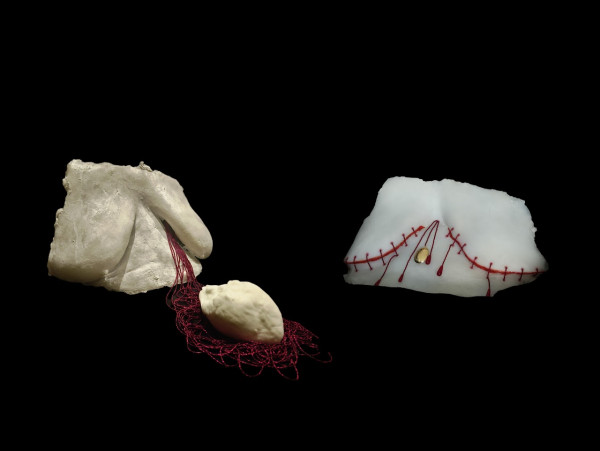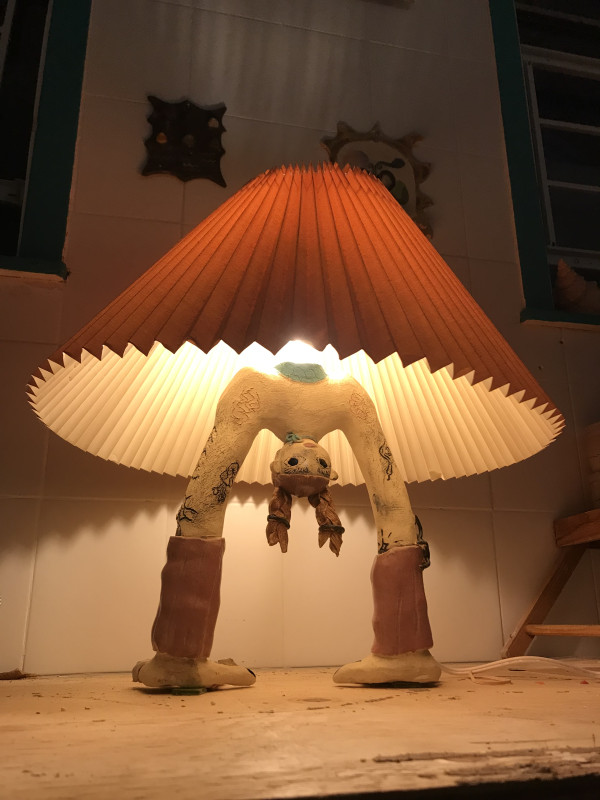What's in View
July 2024
Forged in Glass: Aullar's Journey of Resilience

Aullar, a passionate and resilient glass artist began their journey into the world of glass about five years ago. Their path to becoming a glass artist was anything but linear, but it is precisely this winding journey that has shaped their unique artistic voice. Aullar's story is a testament to the transformative power of art and community, as well as a reflection of their unyielding spirit and creativity.
Aullar's first encounter with glass art was at UrbanGlass, where they took a glass blowing class. Despite feeling intimidated and out of their comfort zone, they were undeterred. This initial experience sparked a curiosity that led them to explore other forms of glass art. It was through these classes that Aullar found a community that was both supportive and uplifting, a rarity in the often competitive world of art.
One pivotal moment in Aullar's journey was their participation in the Bead Project at UrbanGlass, a program designed for underserved women and non-binary individuals. This program not only provided them with skills and confidence but also opened doors to further opportunities, such as a scholarship to attend the Corning Museum of Glass. It was there that Aullar discovered their passion for pâte de verre, a technique that has become central to their work.
Aullar's art is deeply personal, often incorporating elements of their gender expression and body. Their recent piece, "And Here We Are," showcased at the View Arts Center in the exhibition Breaking Boundaries: Contemporary Voices in Glass, is a profound exploration of self. The work features Aullar as they are and as they imagine themselves, embodying the dualities and complexities of their identity. This theme of duality is a recurring motif in Aullar's work, mirroring the inherent characteristics of glass itself—solid yet liquid, opaque yet transparent, fragile yet strong.
For Aullar, glass is more than just a medium; it is a metaphor for their own experiences. They are drawn to this material's dual nature, finding a reflection of themselves in its strength and fragility. "There's something really beautiful and even sexy about glass," Aullar explains. "It's like this idea of something seemingly fragile can be so strong at the same time. It speaks to me as a person."
The support and mentorship Aullar received from figures like Liesl Schubel, the former education director at UrbanGlass, and Jane Bruce, a curator and mentor, have been instrumental in their development as an artist. The glass community, despite its small size, is tightly knit and supportive, providing Aullar with a sense of belonging and encouragement to continue pushing the boundaries of their art.
Aullar's work is also influenced by their mother, who was their first model and has had a lasting impact on their artistic practice. Their pieces often explore trans and non-binary body representation, which are not often found in traditional art. Through their work, Aullar aims to challenge these norms and provide visibility to diverse body types.
In addition to their visual art, Aullar has experimented with performance art, addressing personal struggles such as disordered eating. Their series "Disordered Eating" involved unconventional eating methods to highlight the complexities of eating disorders. This raw and honest approach extends across all of their work through a variety of mediums continually emphasizing the connection between body and creativity.
Balancing their artistic pursuits with the demands of caregiving and a full-time job, Aullar's dedication to their craft is unwavering. Their inclusion in the New Glass Review was a significant milestone, affirming their talent and perseverance. Aullar's recent work includes large blown glass beads, some resembling bodies, which will be featured in an upcoming show at the Pittsburgh Glass Center.
For Aullar, creating art is a therapeutic process, a way to navigate the human experience and connect with others. "Being able to create has been therapy for me," they share. "I can be my absolute self and not have to worry about what anyone thinks." Through their art, Aullar hopes to touch others and make them feel less alone in the world. As Aullar continues to explore and create, their journey serves as an inspiring reminder of the resilience and passion that defines the world of art.
From Frustration to Flourishing: How Cam Built a Community Through Ceramics
Cam began exploring ceramics about four years ago, somewhat haphazardly. "I took one small four-week class right before the pandemic and I hated it," Cam laughs. "I was really bad at it." After a frustrating start, they took a break. But when the COVID-19 lockdowns hit, boredom led Cam back to clay. They bought a banding wheel and began experimenting at home in Vancouver.
It was in their move to Victoria, BC that Cam's passion for ceramics truly ignited. It was the combination of a grumpy, older man, Victoria's tight-knit community and the solitude of lockdown life that allowed Cam to immerse themselves fully in their craft. "I started becoming more obsessed with it [ceramics] in Victoria. I would do it every day because it was better than scrolling on TikTok," they shared. This daily practice not only honed Cam's skills but also became a grounding activity, helping them explore their sexual and gender identities.
Returning to Vancouver shortly after presented new challenges for Cam’s practice that had only just begun. The city's high costs made finding an affordable ceramics space difficult. Yet, Cam's perseverance paid off when they found a small spot at Slice of Life. "It was a dungeon with no windows and bad dust, but it connected me to the art community in Vancouver," Cam explains. The experience inspired them to create a better, more inclusive studio environment.
Cam's vision for their studio was clear: a welcoming, community-oriented space where people could create pottery affordably. With the help of friends, they transformed their idea into reality, founding Swamp, an art collective that quickly became a hub of creativity and camaraderie. "Swamp was started with a really good community of my closest friends. Everyone is very soft and kind, and it's a beautiful group to be a part of," Cam says warmly.
Despite the success of Swamp, challenges persisted. After a year, their landlord doubled the rent, forcing them to relocate. The collective found a new home in a converted wedding venue, where their creativity flourished even more. "We were able to start doing classes more frequently and drop-ins twice a week along with a variety of other events. It’s been really rewarding," Cam notes. However, the threat of demolition looms over their current space, leaving the future uncertain.
Through all the ups and downs, Cam's work remains a testament to their journey and the community that supports them. Their playful lamps, inspired by friends hanging out in nature, reflect the joy and connection they find in their relationships. "A lot of my work is a big love to all my homies and Swamp too," they say.
As Cam navigates the next chapter, they are exploring new artistic ventures, such as cyanotype clay prints and a ceramic table-lamp hybrid. They also dream of hosting their first art exhibition. "Right now, I'm just sitting with all these thoughts of change," Cam reflects.
Their journey from a frustrated novice to a beloved community artist is a story of resilience and discovery. In their own words, "Ceramics was the first practice that made sense with my brain. It was about using my hands and building forms, and those forms made more sense to me than painting ever did."
Cam's story is a beautiful reminder that art is not just about the finished product, but the process and the people you meet along the way. Through their ceramics, Cam continues to shape not just clay, but a vibrant, inclusive community where creativity and friendship thrive.